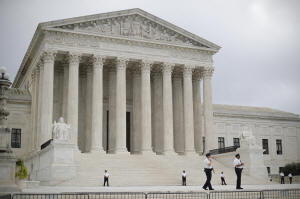How views of the Supreme Court have changed since 2022 abortion ruling,
according to AP-NORC polling
[July 26, 2025]
By MARK SHERMAN and AMELIA THOMSON-DEVEAUX
WASHINGTON (AP) — Americans’ views of the Supreme Court have moderated
somewhat since the court’s standing dropped sharply after its ruling
overturning Roe v. Wade in 2022, according to a new poll. But concern
that the court has too much power is rising, fueled largely by
Democrats.
The survey from The Associated Press-NORC Center for Public Affairs
Research found that about a third of U.S. adults have "hardly any
confidence at all" in the court, but that’s down from 43% three years
ago. As the new AP-NORC polling tracker shows, about half of Americans
have “only some confidence" in the court, up from 39% in July 2022,
while a relatively small number, about 1 in 5, have “a great deal of
confidence,” which hasn't shifted meaningfully in the past few years.
The moderate increase in confidence is driven by Republicans and
independents.
Still, views of the nation's highest court remain more negative than
they were as recently as early 2022, before the high-profile ruling that
overturned the constitutional right to abortion. An AP-NORC poll
conducted in February 2022 found that only around one-quarter of
Americans had hardly any confidence in the court's justices.
Persistent divide between Republicans and Democrats
The partisan divide has been persistent and stark, particularly since
the Dobbs ruling, when Democrats' confidence in the nine justices
plummeted. The survey shows Republicans are happier than Democrats and
independents with the conservative-dominated court, which includes three
justices appointed by President Donald Trump, a Republican.

Few Republicans, just 8%, view the court dimly, down from about 1 in 5
in July 2022. For independents, the decline was from 45% just after the
Dobbs ruling to about 3 in 10 now. The views among Democrats were more
static, but they are also slightly less likely to have low confidence in
the justices, falling from 64% in summer 2022 to 56% now.
In recent years, the court has produced historic victories for
Republican policy priorities. The justices overturned Roe, leading to
abortion bans in many Republican-led states, ended affirmative action in
college admissions, expanded gun rights, restricted environmental
regulations and embraced claims of religious discrimination.
Many of the court's major decisions from this year are broadly popular,
according to a Marquette Law School poll conducted in July. But other
polling suggests that most don't think the justices are ruling
neutrally. A recent Fox News poll found that about 8 in 10 registered
voters think partisanship plays a role in the justices' decisions either
“frequently” or “sometimes.”
Last year, the conservative majority endorsed a robust view of
presidential immunity and allowed Trump to avoid a criminal trial on
election interference charges.
In recent months, the justices on the right handed Trump a string of
victories, including a ruling that limits federal judges’ power to issue
nationwide injunctions.
Katharine Stetson, a self-described constitutional conservative from
Paradise, Nevada, said she is glad that the court has reined in “the
rogue judges, the district judges around the country” who have blocked
some Trump initiatives.
[to top of second column]
|

The Supreme Court in Washington, Oct. 9, 2018. (AP Photo/Pablo
Martinez Monsivais)
 Stetson, 79, said she is only
disappointed it took so long. “Finally. Why did they allow it get
out of hand?” she said.
Growing concerns the court is too powerful
Several recent decisions were accompanied by stinging dissents from
liberal justices who complained the court was giving Trump too much
leeway and taking power for itself.
“Perhaps the degradation of our rule-of-law regime would happen
anyway. But this court’s complicity in the creation of a culture of
disdain for lower courts, their rulings, and the law (as they
interpret it) will surely hasten the downfall of our governing
institutions, enabling our collective demise,” Justice Ketanji Brown
Jackson wrote when the court ruled on nationwide injunctions.
The July AP-NORC poll found a growing similar sentiment. About 4 in
10 U.S. adults now say the court has “too much” power in the way the
federal government operates these days. In April, about 3 in 10
people were concerned about the court’s power.
The shift is largely due to movement among Democrats, rising from
about one-third in April to more than half now.
Debra A. Harris, a 60-year-old retired state government worker who
now lives in Winter Haven, Florida, said the court's decisions in
recent years “just disgust me to my soul.”
Harris said the court has changed in recent years, with the addition
of the three justices appointed by Trump.
“I find so much of what they're doing is based so much on the
ideology of the Republican ticket,” Harris said, singling out last
year's immunity decision. “We don't have kings. We don't have
dictators.”
George Millsaps, who flew military helicopters and served in Iraq,
said the justices should have stood up to Trump in recent months,
including on immigration, reducing the size of the federal workforce
and unwinding the Education Department.
“But they’re bowing down, just like Congress apparently is now,
too,” said Millsaps, a 67-year-old resident of Floyd County in rural
southwest Virginia.
___
The AP-NORC poll of 1,437 adults was conducted July 10-14, using a
sample drawn from NORC’s probability-based AmeriSpeak Panel, which
is designed to be representative of the U.S. population. The margin
of sampling error for adults overall is plus or minus 3.6 percentage
points.
All contents © copyright 2025 Associated Press. All rights reserved
 |